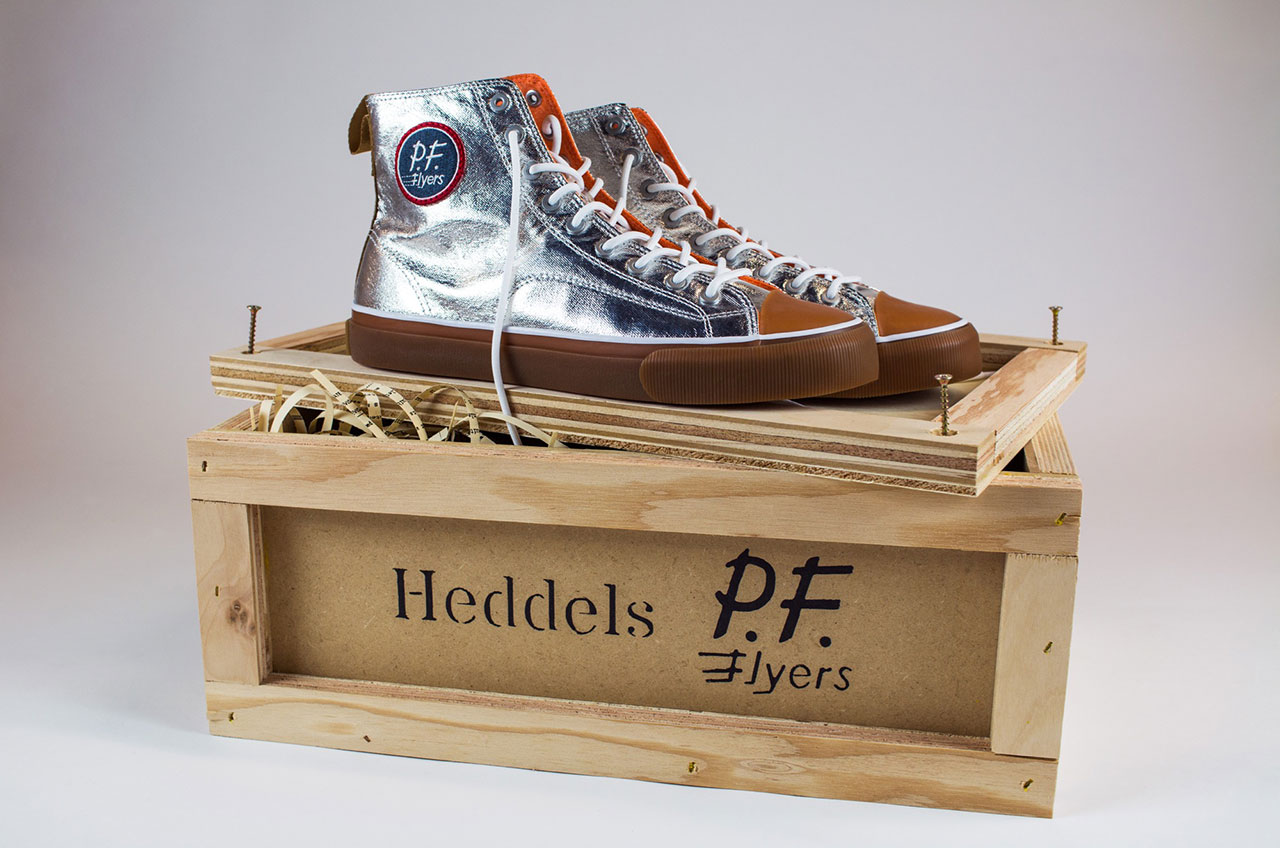Shiny Space Shoes: 'Mercury All American' Sneakers Styled After Astronaut Footwear

You can now take a walk in NASA's original astronaut shoes, or at least a pair inspired by them, if you are among the very lucky few.
Heddels, an online resource for well-made clothing, has announced the "Mercury All American," a sneaker made with the athletic shoe brand PF Flyers. The limited-edition footwear honors PF's role in Project Mercury, the United States' first human spaceflight program, which was established 60 years ago.
"Tens of thousands of people and hundreds of companies were involved in the gargantuan effort to put an American into space. PF Flyers and its original parent company B.F. Goodrich were two such businesses," wrote David Shuck, Heddels' managing editor, in an article about developing the Mercury All American. "While the astronauts wore B.F. [pressure] suits in the air, they had on PF Flyers on the ground, helping them truly run faster and jump higher than anyone in history." [Evolution of the Spacesuit in Pictures (Space Tech Gallery)]
B.F. Goodrich produced the silvery spacesuits worn by the Mercury astronauts. PF Flyers, B.F.'s footwear brand, made military athletic shoes of the same style worn by the likes of Alan Shepard and John Glenn as they prepared for their missions.
Heddels and PF Flyers' Mercury All American blends the two divisions' legacies by incorporating the spec materials used by B.F Goodrich into a silhouette similar to that of the shoes worn by Mercury astronauts in training.
The $380 Mercury All American is limited to just 21 pairs — the same number of spacesuits that B.F. Goodrich delivered to NASA. Heddels is running a free raffle through Sunday (Feb. 11) for the opportunity to purchase the shoes.
Shoe shine
"The concept was to make a shoe that was a microcosm of Project Mercury itself," explained Shuck, "incorporating as many materials and designs from the original program as possible."
Breaking space news, the latest updates on rocket launches, skywatching events and more!
The high-top sneaker features an aluminized nylon Nomex upper, a high-visibility orange lining, a heel pull-tab, nickel-alloy eyelets and paracord laces.
"I felt the key to this whole thing was giving the shoes the look and feel of a piece of the spacesuit. The suit itself was made of a heat resistant aluminized nylon. The most heat resistant nylon material available at the time was Nomex," wrote Shuck.
The silvery material is more than just shiny. Like the spacesuits, the shoes' twill can withstand heat upwards of 3,000 degrees Fahrenheit (1,650 degrees Celsius).
The orange liner material was inspired by the pressure garments' brightly colored satin interior used to help recovery crews spot the astronauts after splashdown. The Mercury boots had olive nylon straps and webbing, which Heddels replicated in the heel tape and loop.
The nickel alloy eyelets, through which the parachute cord laces are threaded, are a nod to the Rene 41 alloy shingles that covered the Mercury space capsule.
The Mercury All American even has its own take on NASA's emblem, a red and blue "P.F. Flyers" patch reminiscent of the space agency's insignia.
Limited landing
The price of producing the Mercury All American out of all authentic materials was that the shoe was destined to be a limited edition only.
"In conceiving this project, both PF Flyers and I imagined a large production run of shoes," wrote Shuck. "But as the details came in and we became enamored with the Nomex material, the retail cost began to rise."
"Materials designed to be blasted into space are generally quite expensive, even if they are 60 years old," he noted.
Heddels will conduct a random drawing of 21 raffle entries on Monday (Feb. 12) to choose who is eligible to purchase the Mercury All American.
Because of the small production run, Shuck said they were able to customize the packaging for the shoes.
"We considered boxes that looked like the portable air conditioners the astronauts carried with them to the launch pad, until we saw these images of wooden NASA shipping crates," he wrote. "And then learned you can ship wooden boxes through the mail."
The Mercury All American will be packaged in a parachute-inspired ripstop nylon drawstring shoe bag and shipped inside a screw-secured wooden shipping crate. Accompanying the shoes will be a brochure about the shoes in the same style as NASA's 1970s informational pamphlets.
Heddels and PF Flyers are not the first to draw inspiration from space exploration for shoes. In 2015, Adidas offered trainers based on the look and feel of NASA's spacesuits. A year earlier, General Electric and JackThreads produced an Apollo moon boot-inspired limited-edition sneaker.
Nike has also looked to space for its footwear, including a Mission Control-themed set in 2013, a sneaker styled after the space shuttle pressure suit in 2012 and a Buzz Aldrin-endorsed pair celebrating the first moon landing in 2010.
See more photos of Heddels and PF Flyers' Mercury All American shoes at collectSPACE.
Follow collectSPACE.com on Facebook and on Twitter at @collectSPACE. Copyright 2018 collectSPACE.com. All rights reserved.

Robert Pearlman is a space historian, journalist and the founder and editor of collectSPACE.com, a daily news publication and community devoted to space history with a particular focus on how and where space exploration intersects with pop culture. Pearlman is also a contributing writer for Space.com and co-author of "Space Stations: The Art, Science, and Reality of Working in Space” published by Smithsonian Books in 2018.
In 2009, he was inducted into the U.S. Space Camp Hall of Fame in Huntsville, Alabama. In 2021, he was honored by the American Astronautical Society with the Ordway Award for Sustained Excellence in Spaceflight History. In 2023, the National Space Club Florida Committee recognized Pearlman with the Kolcum News and Communications Award for excellence in telling the space story along the Space Coast and throughout the world.



